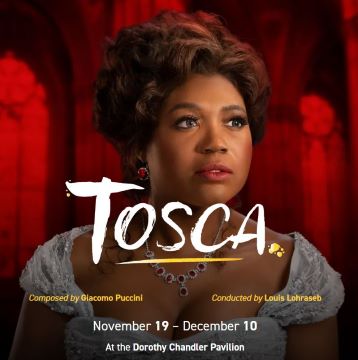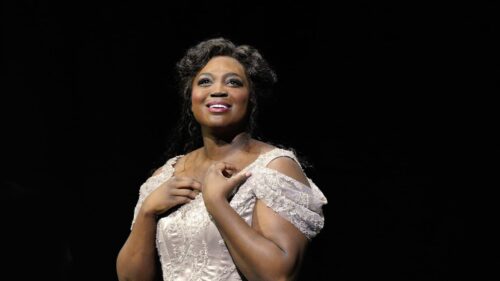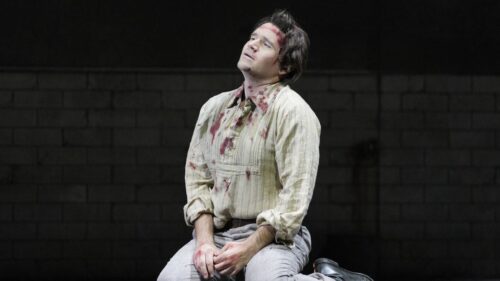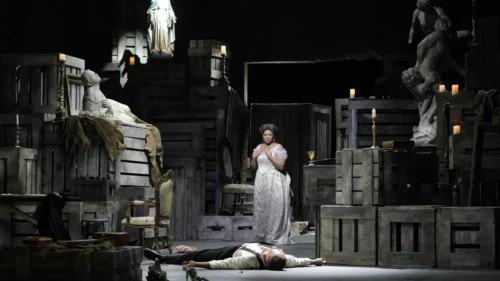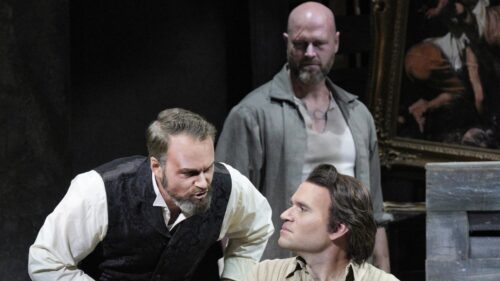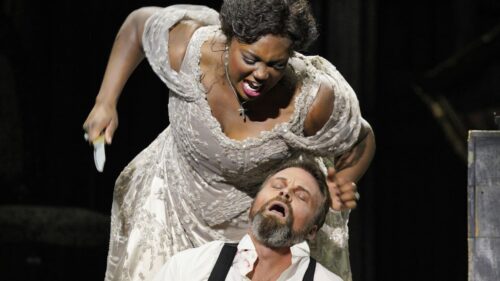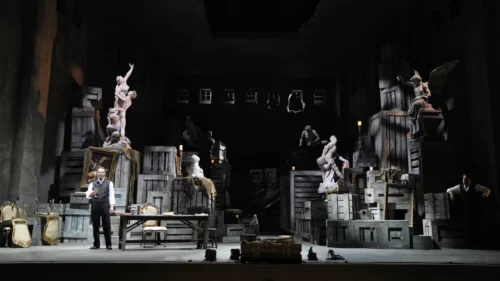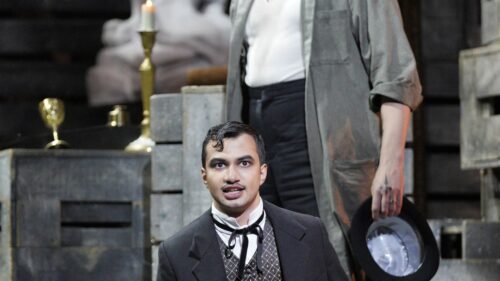AN ANGEL TO THE RESCUE
Well, LA Opera has perked me up all ways from Sunday. As if the recent production of Omar, truly a game changer in the world of opera, wasn’t awesome enough, now comes along a rendition of Tosca that is one of the most beautiful and satisfying that you will ever see. What’s most surprising is that British director John Caird‘s 2010 version has been done before to mixed results at Lyric Chicago in 2015 (this is a co-production with Lyric and Houston Grand Opera, where Caird’s outing plays again next year). The director of Nicholas Nickleby and co-director of Les Misérables follows suit by going for a grittier more humanistic feel, this time in the early twentieth century, with Bunny Christie‘s gorgeous sets and costumes taking on a darker tone. I suspect that some changes have been made since 2010; apparently there was a mysterious child dressed as the Madonna, appearing and disappearing throughout the production. There was nothing spectral here, it was all flesh and blood.
Additionally, no production had as Tosca L.A.’s own Angel Blue who offered concentrated, searing emotion — her full-ringing despair in Act I at Cavaradossi’s presumed infidelity and then, in Act 2, when Tosca is offered a deal by Scarpia — sex in return for Cavaradossi’s release — she prays to God for help, asking why He has abandoned her, in the affecting aria, “Vissi d’arte.” Blue reaches heroic extremes in her suffering, and the opening night audience rightfully tossed prolonged cheers to the stage. Blue’s is a rigorous, strong voice with nary a flutter anywhere, so she sounded alluring in pianissimos and tortured in declarative passages, convincing and forceful with a full and ringing tone. She also acted terrifically, whether playful, vulnerable, or furious.
The plot involves diva Floria Tosca, who jealously suspects the innocent man she loves, painter Mario Cavaradossi (Michael Fabiano, a thrillingly strong tenor who held high notes at full strength) of infidelity with the model for his new painting at Sant’Andrea della Valle in Rome. When a newly escaped revolutionary, Cesare Angelotti (Wei Wu), arrives at the church, Mario helps his friend flee. At the manipulative urging of the evil chief of police, Baron Scarpia (another L.A. native, Ryan McKinny, who had a dark, sonorous timbre that matched his slimy character), Tosca goes to Mario’s home to spy on her lover.
At the top of Act Two, Cavaradossi has been arrested and brought to Scarpia, followed by Tosca, who must listen to the savage beatings of Cavardossi by two henchman, Sciaronne (a very tall and menacing Zachary James) and Spoletta (a very weaselly Anthony León). This Act has a palpable dramatic tension that is stimulating, as we wait for Tosca’s response, which is to slit Scarpia’s throat. Act Three takes place underneath the roof of the Castel Sant’Angelo where prisoners are executed, and where Tosca and Cavardossi meet their fates as well.
Christie, who designed the recent Company on Broadway, had the church in Act I devoid of elaborate ornament, an unfriendly space that housed an unfriendly and distinctly unchristian religion, one whose anemic archbishop saw fit to bless Scarpia at the end of Act I. The reason the church was so bare became apparent in Act II; Scarpia, in addition to being the terrorizer of Rome’s women, was also the plunderer of its churches, his office being crammed with packing boxes and statues. And what fascinating placement. Above Tosca is a giant angel statue, while Scarpia is surrounded by erotic statues, including one between him and Tosca: Pierre Puget’s Versailles marble statue Milo of Croton (now in the Louvre) with a wrestler being bitten by a lion in the ass. The concept of Scarpia as art thief gave McKinny’s smoothly sung, sophisticated Scarpia an unaccustomed power: his relationship with Tosca took on an uncanny, almost incestuous intimacy, because he was a connoisseur, albeit a debased one, of the same values she stood for.
For non-opera folk, this scene is a reminder why Tosca is a perfect introduction to opera. The story is thrilling and suspenseful, the score — especially as led by young conductor Louis Lohraseb in his mainstage company debut — is lush and accessible, and the characters come off as real people, not caricatures. This production, in particular, is great for those who would normally avoid opera: the voices are equally strong, the music is thrilling, and the visuals are stunning, especially the Act One closer in the church with seemingly more people on stage than at a papal blessing, including the LA Opera Chorus (under director Jeremy Frank) and the LA Children’s Chorus (led by Fernando Malvar-Ruiz). Personally, it gave me a whole new insight into the glory of Puccini’s score.
photos by Cory Weaver
Tosca
LA Opera
a co-production of the Houston Grand Opera and the Lyric Opera of Chicago
Dorothy Chandler Pavilion, 135 North Grand Ave.
ends on December 10, 2022
for tickets, call 213. 972.8001 or visit LA Opera
